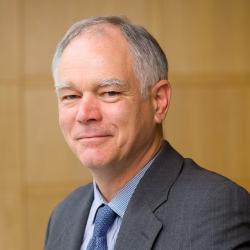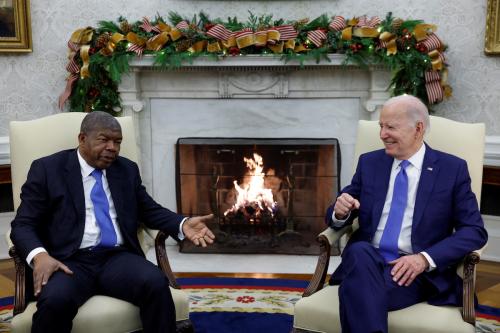The following is a testimony delivered by George Ingram to the Senate Foreign Relations Committee on May 10, 2018. You can view the full hearing here.
Chairman Corker and Ranking Member Menendez, my appreciation for the invitation to testify today, and to Chairman Corker and Senator Coons for introducing the BUILD Act in recognition of the importance of strengthening the U.S. economic development tool kit.
I am George M. Ingram, senior fellow at the Brookings Institution1 and co-chair of the Modernizing Foreign Assistance Network (an alliance of individuals and organizations committed to improving the effectiveness of U.S. assistance).
Data speaks volumes as to the importance of building out the nearly 50-year-old Overseas Private Investment Corporation into a new, strong instrument of development finance.
The seminal Better Business Better World2 asserts that achieving the Global Goals will not just help our planet, it will help our wallets. The report estimates that accomplishing the 17 global Sustainable Development Goals across four economic systems opens market opportunities of $12 trillion, a figure which may double or triple if the full scope of the SDGs is achieved. Aside from trillions in value being at stake, as the report states, “there is also the opportunity to shape a safer, more prosperous world with a more predictable future in which to invest and innovate. There is the chance to rebuild trust between business and wider society.”
In 2015, the Overseas Private Investment Corporation (OPIC) held a total portfolio of $20 billion, while its European sister agencies held more than twice that amount ($45 billion).3 Outstanding balances for the China Exim Bank totaled $378 billion in 2016, and the China Development Bank held $360 billion in international assets. The opportunities are vast, the competition is intense, and the U.S. needs to step up to the challenge.
The BUILD Act addresses that challenge, among other ways, in providing the authority to make equity investments and extend technical assistance; raising the contingency liability to $60 billion; providing a multi-year authorization; and creating strong links between the IDFC and USAID. However, there are ways in which it can be strengthened.
CLEAR DEVELOPMENT MANDATE
The bill establishes development as the mission of the IDFC, but without clarity as to definition or scope. This gap can be filled by a clear definition of, or vision for, development.
A good model is the purpose set forth in the statute establishing the Millennium Challenge Corporation (MCC) to promote “economic growth and the elimination of extreme poverty and strengthen good governance, economic freedom, and investments in people”. Today that objective would be updated by inserting “broad-based”, “equitable”, or “inclusive” before “economic growth”.
The Modernizing Foreign Assistance Network has shared this, and other improvements to the development mandate covering accountability, evaluation, learning, and transparency, with the committee in specific line item suggestions. Especially important is that data be publicly available on a project basis, not just by country, and that the data be timely, comprehensive, and comparable, consistent with the Foreign Aid Accountability and Transparency Act (FAATA).
A further guarantee of a strong development mandate is that some private members of the board have backgrounds, not just in business and finance, but relevant development expertise and experience.
IDFC-USAID RELATIONSHIP
A strong and productive relationship between the IDFC and USAID will be a lynchpin to the U.S. achieving development objectives.
USAID has been a pioneer in leveraging the private sector in its development programs. In the past decade and a half, USAID has participated in more than 1,600 public-private-partnerships. Two signature initiatives are Power Africa, which works with 142 private sector partners (including 69 American companies) to build energy capacity in Africa, and Feed the Future, which has leveraged nearly $830 million in private sector capital investment since 2011.
The bill designates the administrator of USAID as the vice-chair of the IDFC board and suggests the position of chief development officer to coordinate with USAID and the MCC.
The position of chief development officer should be mandated, not permissive. The duties of the office should be enumerated beyond “policy and implementation” to, among other responsibilities: coordination of IDFC development policy and technical assistance collaboration with USAID and the MCC; sharing of resources, data, analyses, and evaluations with USAID and the MCC; oversight of the agency’s responsibilities for monitoring, evaluation, and transparency; and management of the annual report. The officer should be held responsible, in the statute or committee report, for leading a learning agenda with other agencies and a government-wide development finance strategy, both of which will help solidify IDFC-USAID collaboration and program integration.
A mechanism to build collaboration across agencies that has worked well among the military services is employee secondments, assigning members of one agency to another for periods of one to several years.
The fact is, productive bureaucratic relationships cannot be hardwired through statute. While interagency coordination has improved in recent years through initiatives like Power Africa, it ultimately comes down to personalities — the right people in the right places. The committee can play a role in facilitating the relationship. The committee can use its advice and consent to ensure that an appropriate person, someone with extensive development experience, preferably with USAID, fills the position of chief development officer. It also can exercise its oversight role to review how the relationship is functioning.
DEVELOPMENT CREDIT AUTHORITY
The Development Credit Authority (DCA) is a prime example of the critical relationship between the new IDFC and USAID. DCA extends a guarantee (typically up to 50 percent) to an entity to catalyze its activities so they are more developmental. For example, a DCA guarantee can facilitate a financial institution to be more inclusive in its lending. The legislation would move this program to the new agency.
If DCA is transferred to the IDFC, policymakers should consider that demand for DCA guarantees comes from USAID missions, so USAID country staff are the field operatives for DCA. Further, DCA programs sometimes are linked to a USAID program. For example, 10 DCA guarantees, supporting $530 million in finance, are involved in Power Africa.
The draft legislation appears to move the DCA program to the IDCA, but not any underlying authority. So, with appropriate funding, both USAID and the IDFC could operate guarantee programs. It is not currently contemplated for the IDFC to have field staff, so USAID mission staff would, in essence, have to serve as the field staff for guaranty projects of both. Given the difficulty in breaking down agency siloes, it is essential that both agencies establish appropriate policy and employee inducements to catalyze collaboration.
THE OFFICE OF PRIVATE CAPITAL AND MICROENTERPRISE
The bill would move the Office of Private Capital and Microenterprise to the IDFC. This is unnecessary and a mistake.
This relatively small office serves as USAID’s center of excellence and technical knowledge for private sector activities and microenterprise. The centrality of USAID’s work with the private sector to its programs has already been noted. If the office were moved, USAID would simply have to recreate the technical capacity so as to maintain the ability to provide advice and guidance to country missions and other operating units. In fact, given the importance of USAID/IDFC collaboration on projects, and the role that USAID performs in advancing business friendly environments, the IDFC needs USAID to have the technical expertise provided by this office.
Furthermore, consider whether microenterprise activities are more naturally aligned with poverty alleviation, therefore more akin to USAID programs, or to development finance. If the latter, how would moving the office impact the USAID microenterprise legislated mandate?
LABOR, ENVIRONMENT, AND HUMAN RIGHTS
The OPIC statute sets out mandates on labor rights, environmental impact, and human rights. Today expectations and sound business practices are even stronger than when these provisions were written.
Business leaders have come to understand that these are not just cosmetic social concerns, that following them can benefit the bottom line. Companies today are adopting comprehensive commitments on sustainability, as reflected by some 7,500 companies issuing sustainability and responsibility reports consistent with global guidelines. As one example, a broad coalition of international companies that operate in Cambodia are calling on the government to honor the rights of workers to organize and to a minimum wage and to cease harassment and criminal charges against union leaders.
In complying with its legislated mandate in this arena and with corporate best practice, OPIC follows the 2012 Performance Standards on Environmental and Social Sustainability of the International Finance Corporation (IFC). A simple and elegant legislative alternative to the multiple provisions in current law and the draft bill is to substitute for those provisions the mandate that “The IDFC shall follow the guidelines set forth in the 2012 IFC Performance Standards on Environmental and Social Sustainability.”
RELEVANCE OF ENTERPRISE FUNDS
The bill provides the authority to establish enterprise funds by reference to certain sections of the original authority to create the Polish and Hungarian enterprise funds in the 1991 Support for East European Democracy Act (SEED Act). The intent is to transfer the responsibility for enterprise funds from USAID to the IDFC.
The enterprise fund model was innovative in its time, a creative response to the opportunity to introduce private enterprise into Central and Eastern Europe and the former Soviet Union after the demise of the Iron Curtain. Of the resulting 10 enterprise funds, two were shuttered early and the others, having completed their original mission, have closed their doors and used the income from selling their portfolio to repay the U.S. Treasury and to finance legacy development functions. Only the Western NIS Fund (in Ukraine and Moldova) retains investment activity for a few more years. Two more recent enterprise funds are operating in Tunisia and Egypt.
Several matters to consider:
The legacy foundations and scholarship funds are grant-type activities currently overseen by USAID that would be irrelevant and a distraction to the new entity, so the relationship should remain with USAID.
The bill continues the practice of a White House-appointed board for enterprise funds. Is this useful? While some board members have possessed the expertise to perform well, the primary qualifications of others were political connections. What is the value of taking six-to-nine months or so for the White House to appoint the board, another six-to-nine months or so for the new entity to get up and running, and at best two-to-three years before investing begins?
In fact, is specific enterprise fund authority necessary or relevant? As to necessity, the reason for the original statute was to provide authority for USAID to engage in equity investment. The bill already does that in the basic authorities.
As to relevance today, the introduction to a recent USAID evaluation4 of the enterprise funds suggests the answer:
“Despite the enormous challenges of the transition from planned to market economy, the former Soviet bloc countries were very different from today’s developing countries in several important ways…. These (i.e., Soviet bloc) countries did not have, however, a private sector, and in particular, a diversified private financial sector that could support the financial investments needed to transform the economy into a market-based system. This is the gap that the enterprise funds were designed to help to address. They were a solution to a problem in a very specific context.”
Today, just a handful of countries lack some private sector and financial markets. Furthermore, unlike when the enterprise fund authority was first established, if analysis of a country’s financial markets suggests that equity fund activity is appropriate, why go to the time and trouble of creating a new entity? The first step should be to pursue a market option, such as contracting with an existing fund, a social impact fund, an NGO with experience operating in this arena, or issue a request for a proposal. Only if there is insufficient market interest should the enterprise fund option be exercised.
Further, why use scarce grant assistance money when market finance is available? Since 1987, OPIC has committed $4.1 billion in 62 private equity funds in emerging markets. Those equity funds in turn have invested more than $5.6 billion in more than 570 privately owned and managed companies in 65 countries.
Finally, the bill provides authority for the IDFC to establish enterprise funds through referencing relevant provisions in the SEED Act and adding further provisions.
There are several legislative options on enterprise fund authority.
If it is determined that specific authority is relevant to the IDFC, then pull the relevant provisions from the SEED Act into this bill, thereby creating a clean, clear authority. However, I would recommend removing the provision of a White House appointed board, and making clear in the committee report that the existing legacy operations remain with USAID.
Alternatively, as in the past enterprise funds have been authorized by the Congress, let future Congresses decide whether circumstances justify spending grant assistance to establish an enterprise fund.
CLOSING
In closing, I would suggest that the Committee has three balancing tasks in finalizing this legislation.
- Build a strong development finance agency without diminishing USAID’s capability to fulfill its development mission, including on economic growth.
- Establish a clear mandate on the primary mission of development while at the same time providing for a nimble development finance agency.
- Facilitate collaboration and coordination between USAID and the IDFC without one unnecessarily interfering with the functioning of the other while embracing strong accountability mechanisms that have served both OPIC and USAID well.
Chairman Corker and Senator Menendez, I thank you for the opportunity to submit these views in support of the BUILD Act with these workable improvements.
-
Footnotes
- The views expressed in this statement are solely those of the author and do not reflect the views of other staff members, officers, or Trustees of the Brookings Institution.
- Business and Sustainable Development Commission, 2017
- Congressional Research Service, OPIC, USAID, and Proposed Development Finance Reorganization.
- USAID, Europe and Eurasia Enterprise Fund and Legacy Foundation Final Evaluation Report




Commentary
TestimonyTestimony on modernizing development finance
May 11, 2018